Rodents in residence
The traditional abode of a hamster was always a wire cage with a wheel, however now they’ve broken out into something much more interesting – tubing.
As zoos have been redesigned to create more natural environments, on a lesser scale we are doing the same in a domestic setting for our pets, with the hamster, an adventurous rodent benefitting more than most.
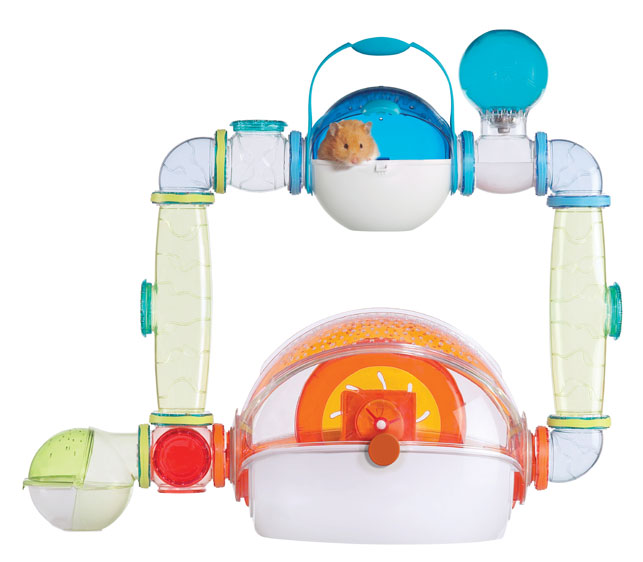
Happy as Harry the hamster: The modular and colourful world of Habitrail should give your hamster endless enjoyment. Now where’s the owner-sized model?
The modular environments for different activities found in Habitrail’s world not only replicate the pet’s natural environment, but provide interactivity with the pet owners through the use of transparent plastics and modern design.
The latest Ovo range is a bright world of activity, creating unique combinations of environments and tunnels for the pet (and owner) to discover.
“My primary objective is to design products that will make the experience of owning a pet a wonderful one!” says Robin Plante, research and development manager at Rolf C Hagen, Habitrail’s manufacturers.
Beginning with handmade prototypes to review the well-being of the animal as well as the ability for the customer to interact, the team then virtually recreates the product in 3D with Pro/Engineer. Here, all the mechanical details are added as well as the moulding parameters for production.
“To validate if our 3D files would work well before making any expensive production moulds, we did several generations of prototypes made directly from our 3D files in stereolithography, and retested the animal well-being, the customer interface, durability of the mechanical details and product assembly, as well as the knock down ability for the packaging size,” says Robin.
The hardest part is designing an end product that fits all the criteria. “Obtaining the perfect balance between the cool factor of the product, manufacturing in mass, durability, affordable for the consumer, easy to use and clean, without making any compromise to the well being of the pet,” concludes Robin.
Puurfect design
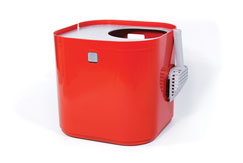
The ModBox is a stylish alternative to the traditional cat litter tray
Cats are particular about many things; what they eat, where they lounge, which item of furniture to scratch the hell out of, and most importantly where they go to the loo.
You’d be hard pushed to find a receptacle for animal faeces that has had as much thought put into it as the ModKat. This feline friendly litter box features a ‘rooftop’ entry that catches gravel as the cat walks out of the box, an ergonomic shovel with a brush to sweep up accidents, and a reusable litter bag to save money and the environment.
“We thoughtfully considered every detail, from non-skid feet that keep ModKat put, to the locking rooftop that keeps nosey pets and curious kids at bay,” says Brett Teper, who along with ModProducts partner Rich Williams, designed the product.
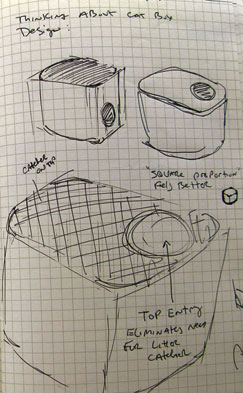
Initial sketches
Truly functional, yes, but form also played a critical role in the design process. “We set out to design a litter box that was aesthetically worthy of occupying prime space in a small apartment, why should one be embarrassed to have their litter box out in the open?” says Brett.
Beginning with sketches Brett and Rich then developed full-scale foam core mock-ups. From there they worked with Cheetah 3D (an Apple Mac-based 3D tool for modelling, rendering and animation) and Adobe Illustrator to develop profile drawings, hole patterns on the top and to flesh out the hinge mechanism that causes residual litter to fall back into the box.
These were passed on to the manufacturer who developed more detailed models in SolidWorks to incorporate the necessary tapering required for the injection moulding process. Several full sized models were made to test for stress, and assess colour and textures.
For further testing real cats were also let loose on the ModKat and multiple breeds, of various ages and ‘unique personalities’, all felt immediately at home. If you treat your cat to this cool looking litter tray, the chances are they might actually like you for once.
Which came first…?
The humble chicken coop has had a renaissance as an environmental wonder, a bastion of the organic – a door step protein producer, which is why it needed a make-over.
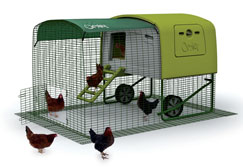
The eglu cube is not your ordinary chicken coop. It’s rotationally moulded from MDPE for easy cleaning, available in seven colours and can house up to ten chickens
“What could be better than collecting eggs from your own hens?” says Simon Nicholls, part of the team behind the eglu, including James Tuthill, Johannes Paul, and William Windham, all graduates from the Royal College of Art, London who together set up Omlet in 2003.
The first step was to get rid of the image of chicken wire and salvaged wooden panels. “Existing chicken houses were all made of wood, a material not particularly suited for animal housing because of the difficulty of cleaning, and they looked drab.” To encourage more people to keep chickens the team decided that the product had to perform better and look much more pleasing.
Since its launch in 2004 the eglu has become the world’s best selling chicken house. The team have adapted the design for rabbits and guinea pigs and in 2006 unveiled the eglu cube, which plays host to up to ten chickens.
“The slide out droppings tray makes the eglu quick and easy to clean and the smooth plastic design allows the surfaces to be disinfected and washed with a hose.” Meanwhile the run is made from strong steel weld mesh and has a unique anti-tunnel skirt to prevent predators from digging in.
After the basic concept and mock-ups a handful of fibreglass prototypes were sent out to potential users to get valuable feedback. “They told us exactly what was missing and what needed to be improved,” says Simon.
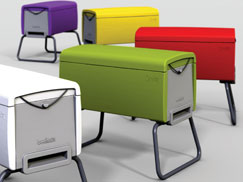
Omlet’s beehaus is designed to take beekeeping into the 21st century
The eglu is rotationally moulded from MDPE and is available in seven colours, creating large, hollow mouldings with insulating properties to keep the chickens warm in winter and cool in summer.
“CAD modelling is used most heavily during the later stages of a project for production tooling and engineering drawings. Our design engineers are fully trained in Unigraphics NX5 and SolidWorks 2009,” explains Simon.
This month also sees the launch of Omlet’s beehaus, designed with leading apiarists to take beekeeping into the 21st century. With its contemporary and easy to use design it is aimed at first time and urban beekeepers.

The latest and greatest pet homes and accessories






